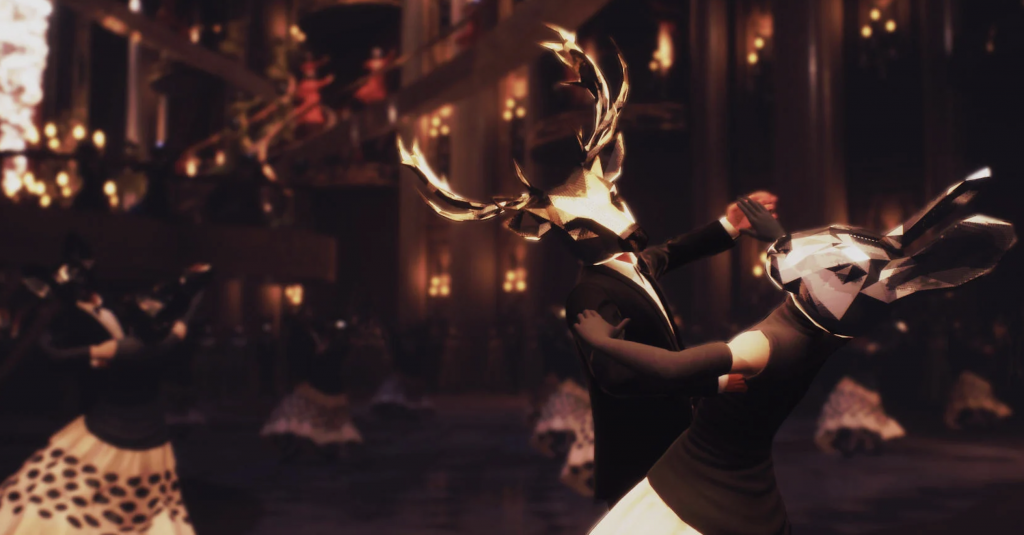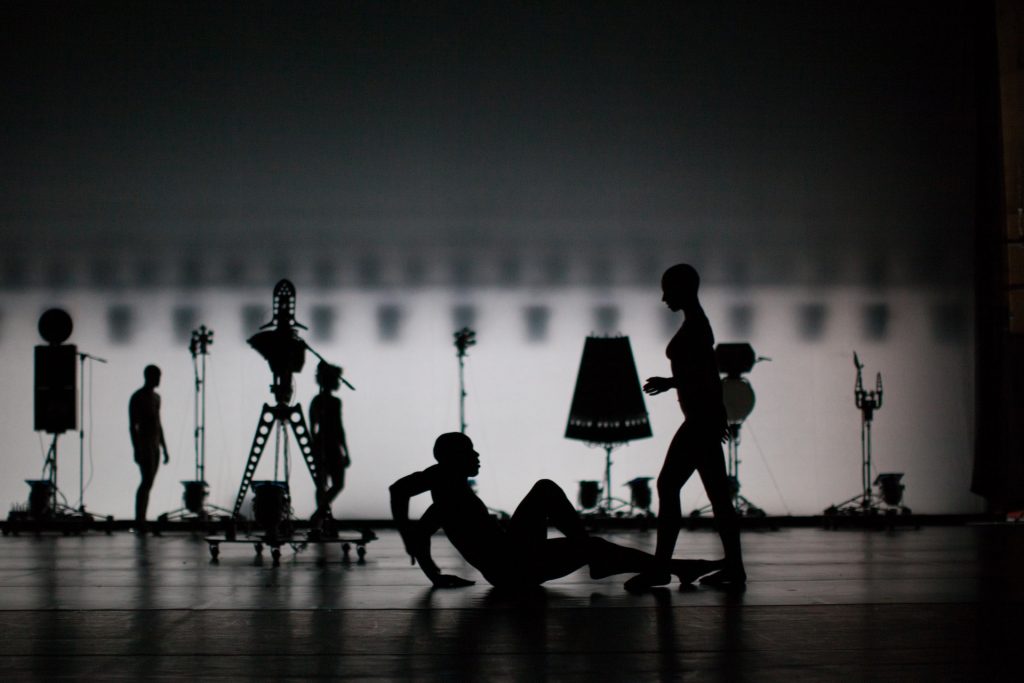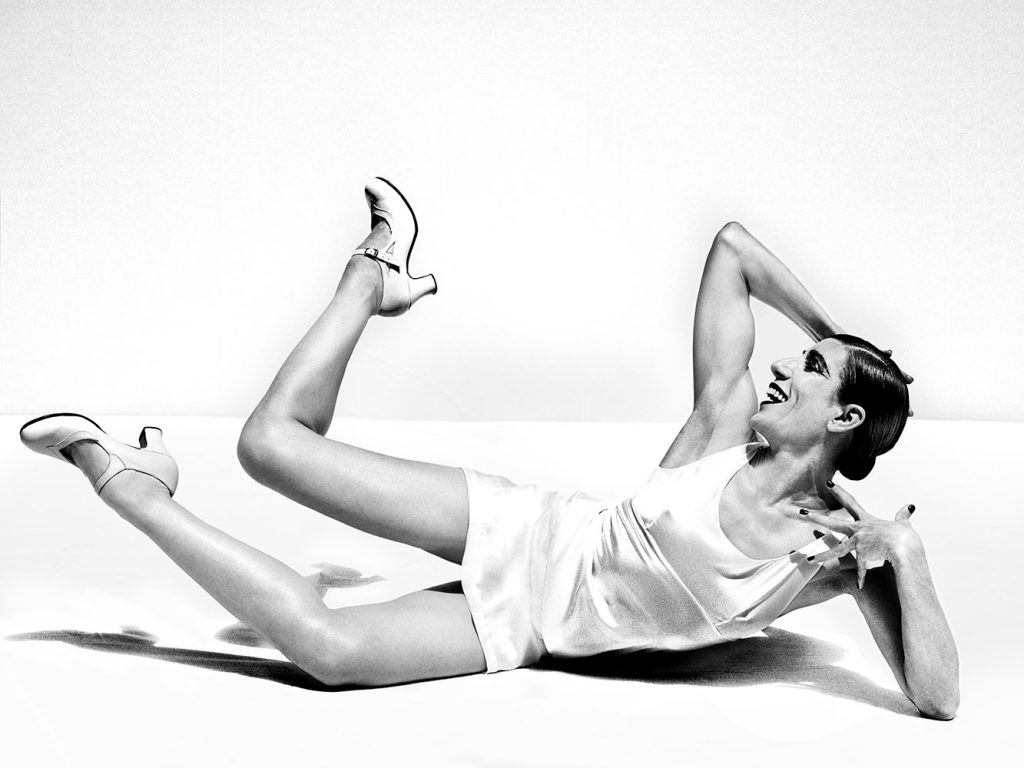Interview by CLOT Magazine

Even the most traditionally-seen art forms seem not to be able to miss the impact of new technologies, and theatre, dance and other performative arts are becoming one of the latest to embrace new forms of its expression. Apart from the most obvious technological enhancement in lighting and stage design, the industry is experimenting with immersive technologies, including virtual, augmented and mixed reality, to discover how these new mediums can take the art form into new spaces.
The possibility of experimenting with new types of narratives – more akin to gaming and role play – as well as new interactivity with the audience are producing interesting results, like the cheekily playful VR online performance adaptation of Shakespeare’s play A Midsummer Night’s Dream by the Royal Shakespeare Company, or 0AR (zero AR) and Celestial Motion, presented by Sadler’s well.
Showing at the Barbican from 19 to 28 May 2022, Le Bal de Paris, directed by worldwide renowned Spanish choreographer Blanca Li is an original virtual reality show where music and dance merge with VR and body-tracking technology. Audiences are invited to the biggest party in Paris as they enter a poetic and dreamy universe. As they dance, move and interact with real-life performers and the other guests, they follow a heart-warming love story unfolding in locations including a monumental, glamorous Parisian ballroom and a magical garden party. The show was presented in 2021 and won the Best VR Experience award at the 78th Venice International Film Festival.
Blanca Li, who is one of the most sought-after choreographers, has always experimented with pushing-forward thinking and breaking the norms and unconventional proposals, like the Flamenco-Rap fusion band she started during her formative years in NYC. Since those early days, she’s worked with the biggest cultural institutions such as the Paris Opera Ballet, The Berlin Ballet, and the Metropolitan Opera, or popular culture figures like directors Pedro Almodóvar and Michel Gondry or musical artists like Beyoncé, Daft Punk, Paul McCartney and Kanye West.
Whether it is performance, opera, musical, museum installation, event, music video or feature film, she is not put off by any form of artistic expression, never restricted to one style, while at the same time getting her inspiration from a wide range of physical forms of expression (it be classical ballet, flamenco, contemporary dance or hip-hop). Her attraction to novel technologies and anything that’s exciting and new and the idea of being able to create with new tools has led her to be a visionary and create shows such as ROBOT!, which included the famous NAO robots (2017) or a 360 VR experience already in 2014.
With this insatiable curiosity for knowledge, her productions are filled with very special energy and light and strength that beam from her personality. Recalling her words in an interview for the Guardian in 2017, where she mentioned she was not dancing that much anymore and being more focused on directing, and even though she can still dance flamenco, my body’s really strong… But I’m getting older. Your body changes. Then, with a glint in her eye, she adds: “I don’t mind if I cannot dance anymore. I can still party”.


You have been running your own dance company since 2003, with huge success. In 2013, on the 20th anniversary of the company, you premiered ROBOT in collaboration with Japanese artists Maywa Denki and NAO robots and last year Le Bal de Paris. Where does this interest in novel forms of technology come from, and what excites her about incorporating them into your practice?
I have a lot of curiosity; if I find an original artistic idea or one which would require to use of the technical medium in an original way, I immediately get interested and start thinking about possible uses for this idea or medium. New technologies have always attracted my attention. I love the idea of being able to create with new tools, trying to make what hasn’t been done yet! But there has to be first an artistic concept that the technology can help; I’m not interested in using new technology for itself.
A few years ago, I tried one of the first VR headsets with a 360 short movie in which the viewer was a passenger on a roller coaster. I thought the feeling of movement was amazing, and I followed up in 2015 by directing a virtual reality film where the viewer is at the centre of a dance performance: Blanca Li 360.
Yet, I missed that the dancers were not physically present and that it was impossible to participate. The creation of the experience Le Bal de Paris comes from my willingness to create an immersive and interactive virtual reality live show where the performers and spectators are present and can touch each other and dance together. When I was told at the beginning that it had not been done at this scale and that it would be very difficult (some VR professionals even told me it would be impossible), I got even more excited and threw myself into studying the possibilities to achieve it. It took me nearly 4 years.
Le Bal de Paris is the first time a show has taken place live and in virtual reality simultaneously; what are the main challenges in dealing with this duality, being in a live and virtual reality world simultaneously?
First of all, I started to learn how motion capture and real-time animation work to be able to adapt to the dream I had in mind. One of the biggest challenges of this experience was indeed to have in real-time ten participants and three dancers in full-body awareness in the same environment, with enough precision so that they could make hand contact and dance together. We wanted to keep a relatively simple motion capture setup, for budgetary reasons, of course, but also to be able to install it easily and perform on tour in a variety of venues.
The actual state of technology sets a limit on many aspects, like the number of participants allowed in a room (something which we keep trying to push up), or the fact that different participants can be in the same real space but are in different stages of the VR universe, like in the labyrinth. I also had artistic ideas which were very challenging; for example, there is a scene where we enter a small cabaret, and I wished that the public could get served a real drink at this time, but it was very complicated to set up to combine it in virtual reality and real life.
We managed to combine all our wishes because the show is not only in virtual reality; there is a transition to the real world in a second ballroom in real life where a dancer from the company teaches you some steps, and you can finally get a (real) drink.
I also like that the final stage of a project has some imperfections, and some accidents, which make the experience unique, entertaining and funny as long as they don’t break the main concept, this requires a lot of open-mindedness and resources in directing, which I learned a lot, especially from creating my show ROBOT.
Le Bal de Paris is an entirely immersive experience in which the audience is encouraged to interact with the live performers and become performers themselves. In terms of the performance/performers and the show choreography, how does this change the design and directing experience? What does it mean for you to have one side, another dimension to create a movement for and, on the other, add the more interactive part performer-audience?
When I started writing about this experience and thinking about how to design it, I searched for partners who knew how to work with virtual reality. We decided to produce it together with Backlight and worked on it for two years, testing all kinds of movements and seeing how it was animated in VR, with many surprises down the road.
Inventing the choreography that was motion captured for the animation of Le Bal de Paris was very interesting to work with the dancers because we had to look for rather simple steps and movements so that our avatars could have a certain fluidity.
In other words, the choreography is a specific work: we had to find out which are movements allowed by virtual reality and its equipment, headsets and backpacks and all the technical constraints. It also allows representation of some movements that would be impossible in real life because their source is the trackers, and you can play with their positions outside of what is natural. I had a lot of fun playing with this.
As a whole, I treated the different aspects of this show in the same way I usually do when I create a show. Except that this time, instead of happening on stage, as usual, it happens in a virtual world.
The fact that dancers are mingling with the spectators is also very new and interesting, it forces the choreography to match the audience’s needs and behaviour, and dancers have some freedom in their interpretation. There is a physical dialogue that is established between the performers and the audience, but the fact that it is lived and seen in the virtual world takes it one step beyond compared to physical immersive theatre.
Could you tell us a bit more about how the project has been developing, along with your personal experience? How have both influenced each other? And what were the biggest challenges?
I came from Martha Graham’s formation in New York and, therefore from contemporary dance. I had also been performing in experimental bands in the underground New York scene and performed in immersive theatrical shows like La Fura dels Baus. I created cabaret evenings in Paris in the 1990s.
I also started choreographing music videos, like Around the World by Daft Punk, directed by Michel Gondry, and I also discovered the world of fashion with Jean-Paul Gaultier, Azzedine Alaïa, and many others, who were always interested in surprising the public. I learned about cinema with Jean-Jacques Annaud, Michel Gondry and Pedro Almodovar, who became friends. I had a thirst to create without compartmentalization between art forms, at the crossroads of different disciplines.
I have thus created a personal array of creative tools for the audiovisual and for the stage outside my company, which feeds my creations. That’s how I came across virtual reality, which is a technology that interests me enormously for its innovative features! But I am very serious, and I take my time to study as much as I can before taking a new style or technology into my creations.
When I decided I was ready to integrate VR into a full-size company show, of course, I did not foresee all the difficulties that I would meet, even though I knew there would be many. Maybe the biggest and first challenge was financing this project, which is very costly. Luckily, we managed to combine private funding from many partners (from France, the USA and Taïwan) with public funding from the cinema system, as VR is considered part of the movie industry. Working through the health restrictions imposed by the Coronavirus pandemic was also an unforeseen challenge, which had like all challenges, its good sides and bad ones.
Costume design by fashion house CHANEL and virtuosic musical score by Tao Gutiérrez, How did these collaborations happen? How would you say each complemented the other’s work?
Tao Gutierrez is a composer and musical director with whom I usually work, both on stage and in films. He was inspired by the idea of a beautiful Ball in Paris and proposed a lively musical creation in perfect coherence with the festive visual identity of the virtual reality show.
For the costumes, I wanted to work with a “Maison de haute couture”: I wanted the show to be very Parisian. I asked Chanel, and they accepted to collaborate with me, both artistically and financially. The beauty of the dresses and costumes had a great impact to push back the limits of what virtual reality technology could do. Indeed, it was important to achieve a certain precision and fluidity in the movement of the clothes so that they would be as lively and beautiful as the models that were inspired from.
The music and costumes complement each other as part of the virtual reality experience and are essential in the festive and spectacular spirit of Le Bal de Paris.
Next year marks the 30th anniversary of the Blanca Li Dance Company; what would be one of the main reflections of this journey? And after the experience with Bal de Paris, where do you see taking it forward?
I have always created shows in which I expressed my taste for mixing styles and cultures. I also don’t like repeating myself, and I am always looking for a new theme, a new source of inspiration. I feel very lucky that I have many projects and ideas in store, more than I could realize in a lifetime.
Some come up when they are ready; others stay in my mind until another idea or an encounter triggers its development. In 1992, I created the contemporary dance show Nana et Lila with nine dancers, based on Gnawa music and trance ceremonies that I had experienced while living in Morocco after my New York years, I then created shows and films drawing on my experience of flamenco, hip hop (Macadam Macadam, 1999), electro-dance (Elektro Kif, 2010 then Elektrik, 2018) or even circus art.
I like a lot to learn and to experience, to try to understand our universe to create shows out of it, it’s my professional talent. It is in the creation process that I am the most serene and fulfilled, even though it is an adrenaline-filled moment. (I’ve been told that adrenaline is what allows you to keep a clear mind and make proper decisions when under threat).
That would be the main reflection of my journey. I live through dance, but for me, it is not a whole. Dance has always been, for me, a way of life. It takes me to other worlds on incredible journeys, and I let myself be carried along. Dance has led me to interpret paintings, literary works, the art of antiquity, many different musical forms and styles, or existential questions, and stage these with techniques and tools from virtual reality, the circus, fashion or cinema. I am led by my knowledge of movement and dance, but it always takes me towards other artistic disciplines, where I draw inspiration and which feed my creativity.
Le Bal de Paris de Blanca Li was a way to venture into a new mode of expression. I learned a lot from virtual reality technology. Now we are getting ready to start the tour with dates in London, Italy and Switzerland. We are also continuing to work on improving the show by thinking about how to improve our avatars and by being aware of the innovation of VR equipment.
I like technology because we can invent new ways of storytelling that did not exist before, we can imagine the future.
In times of social and climate crisis, complicated relationships with technology and political strain, what role do you think choreography and dance play today in describing contemporary society?
I think that live performance and theatre are something so powerful that it has crossed all civilizations, and they should always be there, with the same concept and strength as when Greek theatre was born 25 centuries ago, for example.
I also think that as soon as new forms of creation are within the reach of artists, we must be able to seize them and continue to express our vision of the world through them. This is what I am interested in, wondering what we can do today that we couldn’t do before. It is also our role as artists to invent the future, to help the audience understand it and master it instead of being a victim of the evolution of the world, which is happening faster and faster.
I often receive questions about the disappearance of stage performances due to the invasion of our lives by digital tools and streaming platforms, but I think nothing will replace the unique experience of witnessing a live performance, whether theatre, music or dance.
I believe theatres will stay as necessary places where humanity can face art, ideas, and existential challenges and find answers to their questions. Different artists keep staging these concepts, and human live performance is always fundamental, cathartic, and a source of strong and unique emotions for their audience.
This is what I feel like a director of the Teatros del Canal, where companies from across the world and different political or social points of view meet an enthusiastic audience, as long as their work is well made and challenging and carries an artist’s statement.
What is your chief enemy of creativity?
Fear: When I have to create, I have to isolate myself from all the feelings that could stop me: the fear of failure is like a wall I have to overcome to be fully free as an artist. I have to feel that there are no limits in my mind and to use only material constraints as creative elements.
Sometimes, I also have to stop listening to others and concentrate on my goal. I have to take risks, including the risk of being wrong, but the only way to do so is to be honest and find out by myself.
You could not live without…
I could not live without seeing my family and friends. Even when I am fully involved with a creation, which means I am 24 hours a day obsessed with creative work, I need to take time out, to eat, to talk about something totally different, and that naturally takes place with my family and friends.






